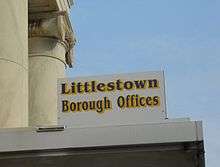Borough (Pennsylvania)
In the U.S. commonwealth of Pennsylvania, a borough (sometimes spelled boro) is a self-governing municipal entity, best thought of as a town,[1] usually smaller than a city, but with a similar population density in its residential areas. Sometimes thought of as "junior cities", boroughs generally have fewer powers and responsibilities than full-fledged cities.

Description
All municipalities in Pennsylvania are classified as either cities, boroughs, or townships.[2] The only exception is the town of Bloomsburg, recognized by the state government as the only incorporated town in Pennsylvania.[1]
Boroughs tend to have more developed business districts and concentrations of public and commercial office buildings, including court houses. Boroughs are larger, less spacious, and more developed than the relatively rural townships, which often have the greater territory and even surround boroughs of a related or even the same name.
There are 958 boroughs and 56 cities in Pennsylvania.[2] Many home rule municipalities remain classified as boroughs or townships for certain purposes even if the state's Borough and Township Codes no longer apply to them.
References
- Trostle, Sharon, ed. (2009). The Pennsylvania Manual. 119. Harrisburg: Pennsylvania Department of General Services. p. 6-61. ISBN 978-0-8182-0334-3.CS1 maint: ref=harv (link)
- Trostle (2009), p. 6-3.